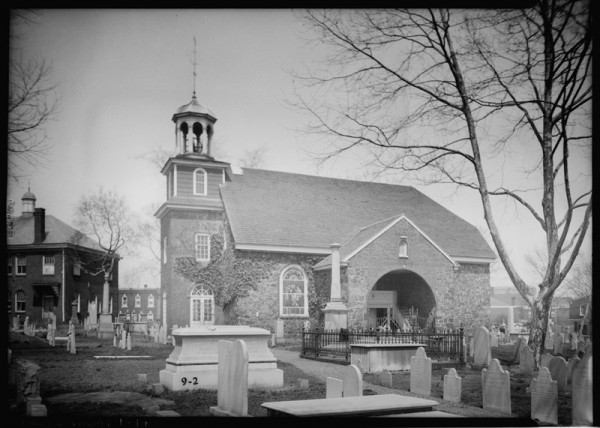
Edward M. Rosenfeld, “Southwest View of Old Swedes Church,” Wilmington, Delaware, April 20, 1934. (Historic American Building Survey, Library of Congress.) The church was built between 1698 and 1699.

Chest, probably made by Christian Joransson (1664–1716), Wilmington, Delaware, 1700–1713. Walnut and tulip poplar. H. 24 1/2", W. 48", D. 20 3/4". (Courtesy, Trinity Episcopal Church; photo, Gavin Ashworth.)
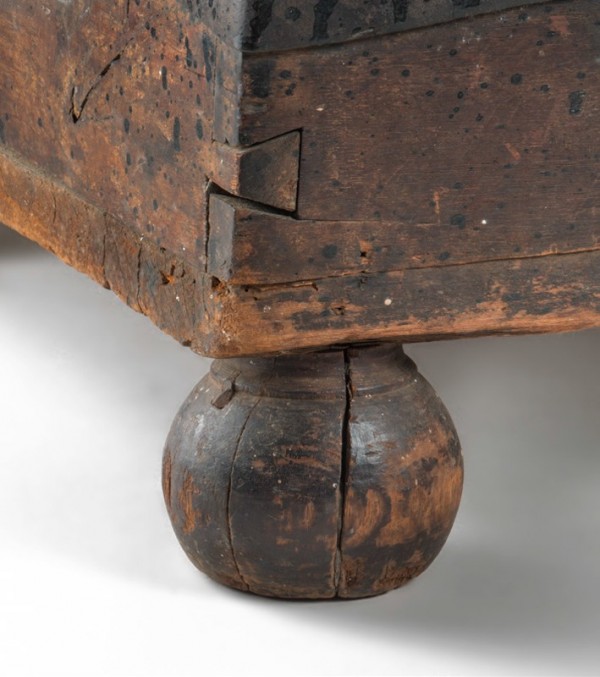
Detail showing an original ball foot on the chest illustrated in fig. 2. (Photo, Gavin Ashworth.)
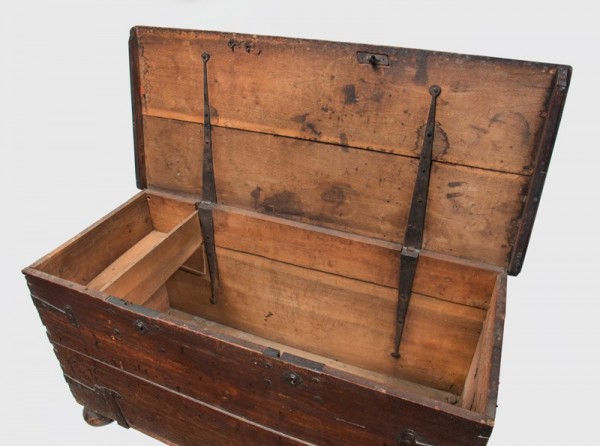
Interior view of the chest illustrated in fig. 2. (Photo, Gavin Ashworth.)
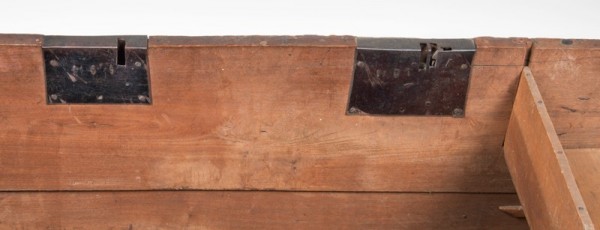
Detail showing the locks on the front of the chest illustrated in fig. 2. (Photo, Gavin Ashworth.)
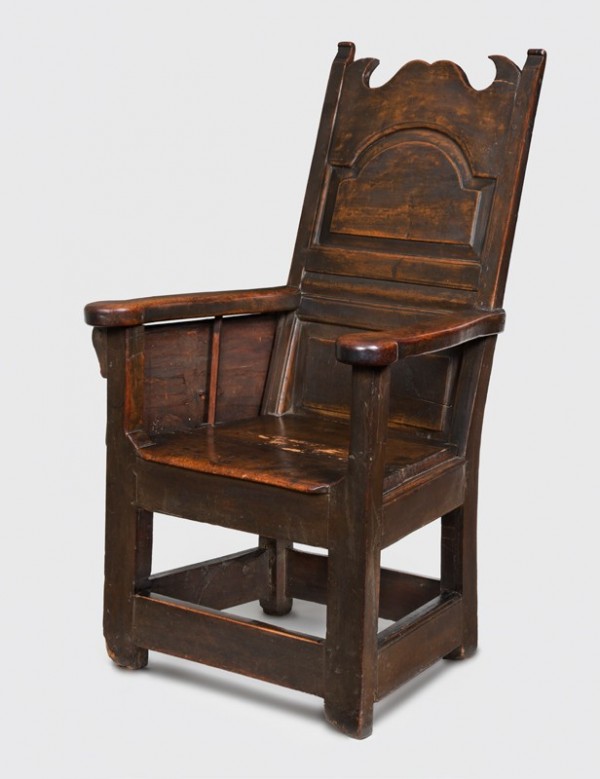
Armchair with later hinged shelf, probably Wilmington, Delaware, 1710–1730. Walnut. H. 47", W. 27 3/4", D. 29". (Courtesy, Trinity Episcopal Church; photo, Gavin Ashworth.)
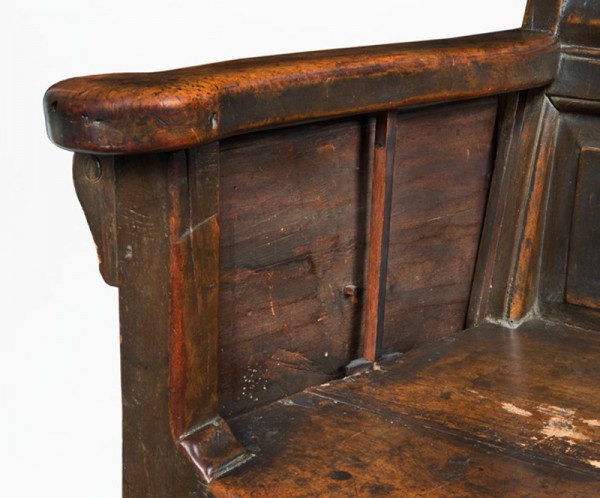
Detail of the writing arm support and underside of the arm of the armchair illustrated in fig. 6 showing evidence of grooves cut for a panel.
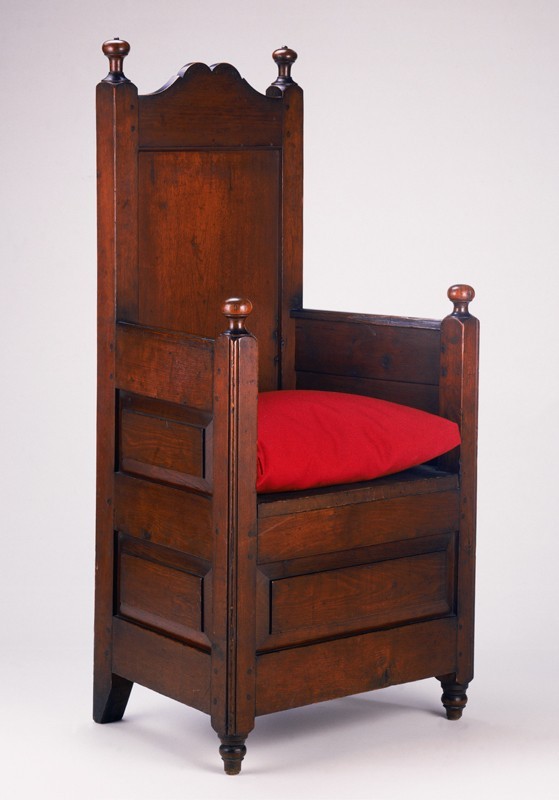
Armchair, southeastern Pennsylvania, 1715–1735. Walnut with tulip poplar. H. 48 1/2", W. 23 1/2", D. 18". (Courtesy, Philadelphia Museum of Art.)
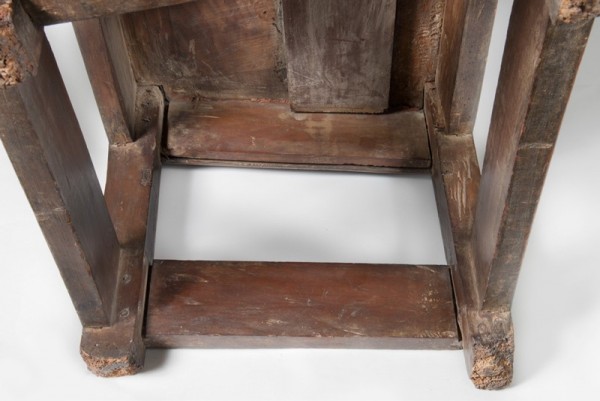
Detail of the underside of the seat of the armchair illustrated in fig. 6, showing the original seat boards, a later board reinforcement, and evidence of drawer runners on the legs. (Photo, Gavin Ashworth.)

Detail showing the seat overhang and arm support of the armchair illustrated in fig. 6. (Photo, Gavin Ashworth.)
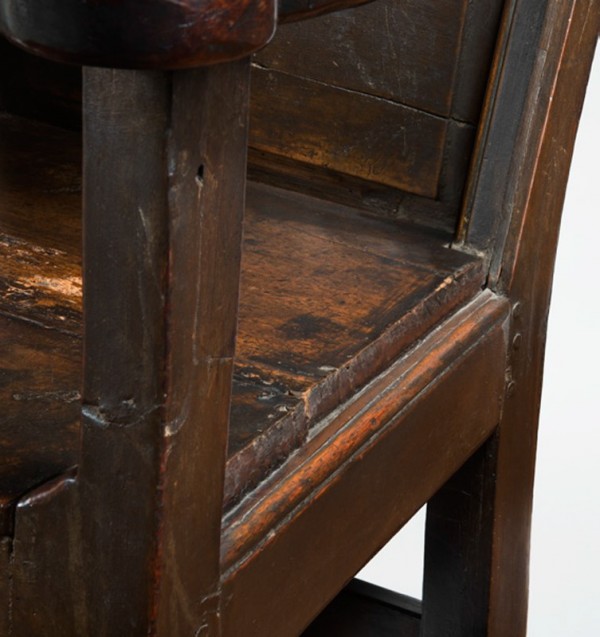
Detail showing the cut seat and filled channel for a panel on the armchair illustrated in fig. 6. (Photo, Gavin Ashworth.)
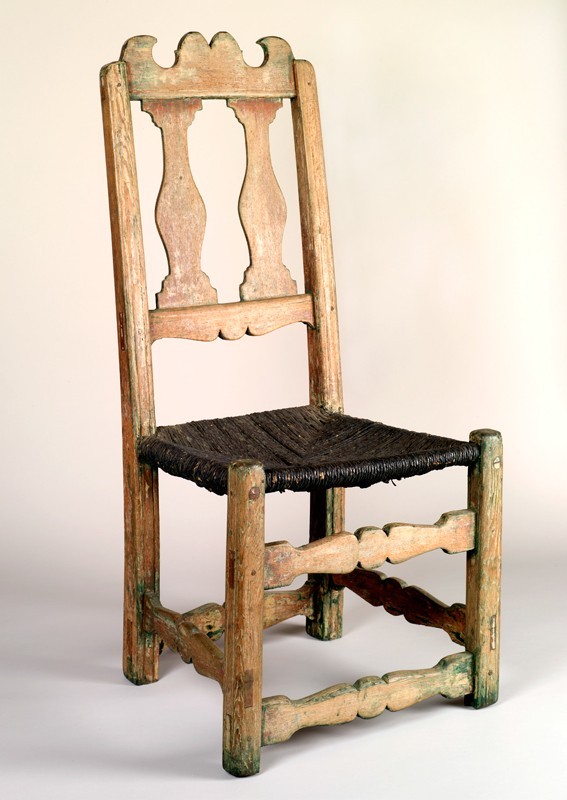
Side chair, probably Wilmington, Delaware, 1730–1750. Sassafras. H. 40 1/2", W. 18 1/4", D. 20". (Courtesy, Winterthur Museum; photo, Lazlo Bodo.)
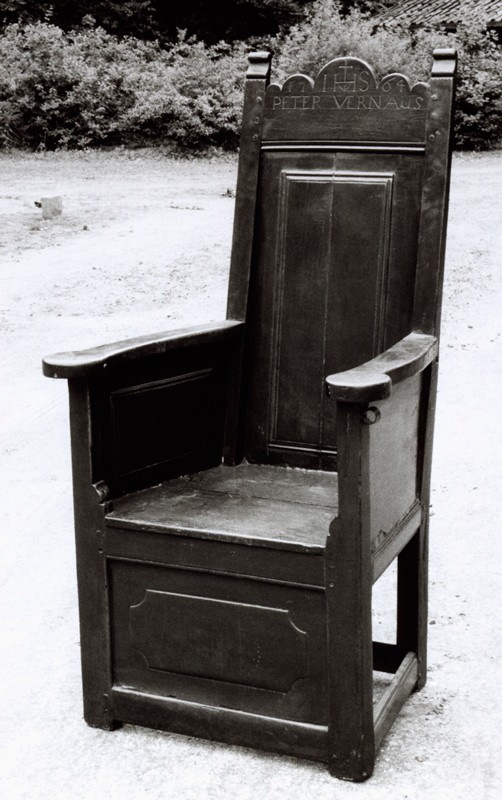
Armchair, Limburg region of the Netherlands, 1764. (Courtesy, Rijksmuseum.)
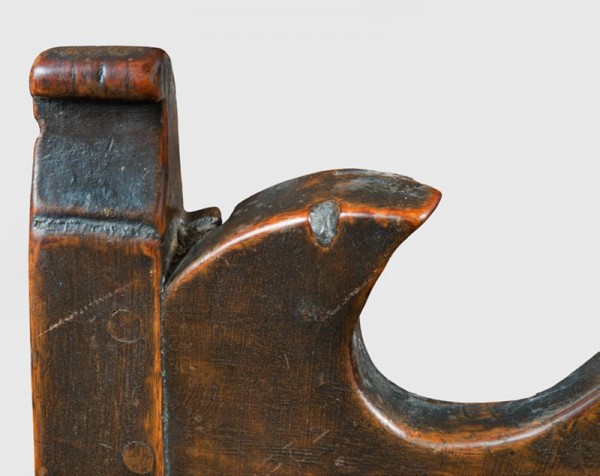
Detail of the rabbeted joint securing a stile and the crest rail of the armchair illustrated in fig. 6. (Photo, Gavin Ashworth.)
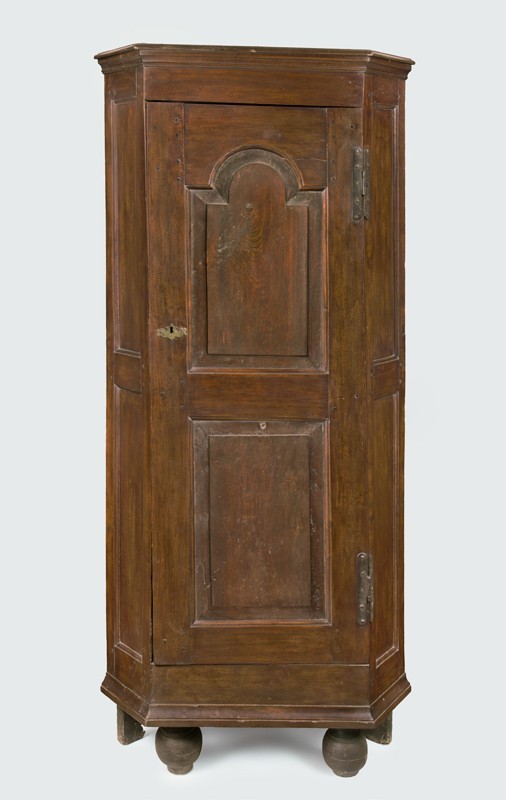
Corner cupboard, probably Wilmington, Delaware, 1710–1740. Walnut with tulip poplar. H. 67 1/2", W. 28 1/2", D. 21". (Private collection; photo, Gavin Ashworth.)
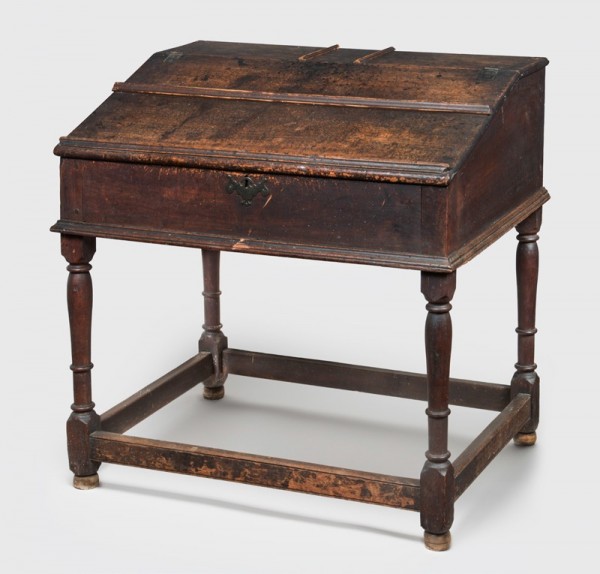
Reading desk, probably Wilmington, Delaware, 1710–1740. Walnut with tulip poplar and hard or yellow pine. H. 36", W. 35 1/4", D. 26". (Courtesy, Trinity Episcopal Church; photo, Gavin Ashworth.) The second (middle) book stop on the desk lid and the two molding strips on the center top, all made of a resinous pine, are not original. Use of wire nails to secure them suggests they were added after about 1875. Other features of note include the iron lid hinges, which are especially well made, raising the question of whether they were made in the Delaware Valley or imported from Europe. The desk maker recessed slightly the underside edges of the lid along the front and sides. Presumably, this refinement was to smooth the surface that contacts the frame and perhaps to reduce the visible thickness of the lid. He also oriented the grain of the pigeonhole sides horizontally, so that end-grain shows. This departure from the norm may signal his lack of familiarity with construction details of this furniture form. Similarly, he reinforced the fitted interior by driving a peg through the exterior side of the case into the end of the low shelf that runs side‑to‑side.
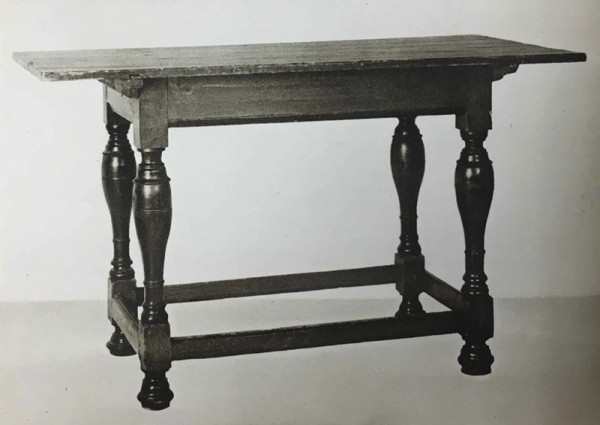
Swedish table illustrated in Sigurd Erixon, Möbler och heminredning i svenska bygder (Stockholm: Nordiska museets förlag, 1925.)

Detail showing the backboard and dovetailed recess of the reading desk illustrated in fig. 16. (Photo, Gavin Ashworth.)
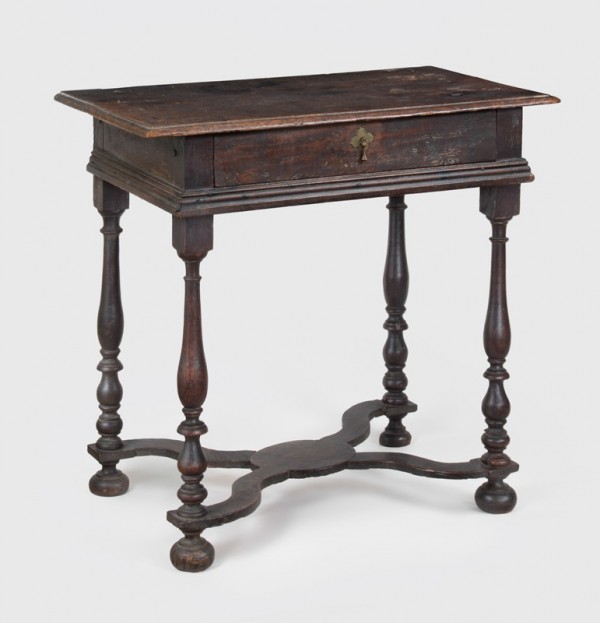
Table, probably England, 1710–1730. Oak. H. 27 1/2", W. 29 1/2", D. 16 3/4". (Courtesy, Trinity Episcopal Church; photo, Gavin Ashworth.)
A dovetailed chest prominently displayed today in the nave of Old Swedes Church (figs. 1, 2) prompts several questions that ultimately inform broader issues relevant to the history of early furniture made in Delaware and Pennsylvania. A paper label, framed and attached to the lid, quotes a 1713 church record mentioning “the chest given by Christian Joransson.” By implication, the viewer is meant to assume that Joransson made this chest. But did he? No early American furniture made by Swedish settlers has yet been identified with reasonable certainty, and the Delaware Valley Swedish community in general remains poorly portrayed. This chest and two other early eighteenth-century pieces of furniture, all owned by the same church, warrant further investigation.
In 1638 part of a larger Swedish migration to the Delaware River Valley disembarked at Fort Christina (now Wilmington). They and others who arrived in successive years established farms in the area where the Christina and Brandywine Rivers empty into the Delaware. The settlers formed a Lutheran church in 1640, led by the Reverend Reorus Torkillus (1608–1643). Fifteen years later, armed Dutch forces under Peter Stuyvesant (1610–1672) took control of the fledgling colony of New Sweden, but with neither an influx of their own countrymen nor a minister of their own, the Dutch who remained worshiped in the Swedish church. That church, named Holy Trinity but commonly called Trinity Parish, sustained Swedish vitality through much of the eighteenth century despite changes and gaps in pastoral leadership. In the seventeenth century, Trinity Parish enjoyed a modest presence in the young colony until the arrival of the Reverend Erik Björk (1668–1740) in 1697. Björk was one of three pastors dispatched by Swedish King Charles XI (1655–1697) to bolster struggling congregations of the Swedish Church in the Delaware Valley. Within a year, the energetic and capable Björk had unified the divided church community on both sides of the Christina River and persuaded its parishioners to build a substantial stone church building, which stands today as Old Swedes.[1]
The Chest
On June 24, 1701, Björk wrote: “Talked of a Church chest in which the income of the Church should be put, and I relieved from the reckoning which is now burdensome to me.” This entry in the Old Trinity Church records reveals that Björk persuaded lay leadership, called wardens or vestry, to assume responsibility for overseeing church finances. Pew rents and periodic collections at church services contributed toward paying the ministers’ salaries and other costs. Careful management entailed regular account reconciliations. Given the absence of banks or other repositories, specie and other items of value had to be stored safely—hence the call for a church chest. At a general meeting of the congregation exactly twelve years later, Björk recorded:
“resolved that the church money shall be deposited in the chest given to the church by Christian Joransson for that purpose, which should always stand in the church, the Churchwardens keeping the key of the same, so that whenever any of the members of the congregation want to make change in payment, it can be made to them by the Churchwardens in the church, and thus all mistakes and misunderstandings be obviated.”
Christian Joransson (also called Christiern and Urinson) appears elsewhere in the church records as well. He pledged £1.10 in 1697 in support of the new church and appears in the accounting of those who contributed time, having worked 33 and 1/2 days on the roof and other carpentry tasks. He is named as the carpenter on the priest’s house built in 1701. At a special meeting called in August, a year after the record of his gift of the church chest, Joransson was elected one of two “church watches,” whose duties were to “keep good order and propriety both within and without the church during God’s service” in an effort to stem the lack of “improvement” that the pastors observed among the congregation. Joransson died in 1716 at age fifty-two.[2]
The large chest on four ball feet still stands in Old Swedes Church. Its design, materials, and construction support its identification as Joransson’s church chest. The front, sides, and lid are each made of two boards. Dovetails secure the front and side boards, but the rear—a solid piece of tulip poplar in excess of one inch thick—fits into a rabbet cut into the back edge of the chest sides and is nailed in place. Likewise, two tulip poplar bottom boards are nailed to the bottom edges. Four ball feet, the left front of which appears to be original, have round tenons that engage holes bored in the bottom (fig. 3). The top has cleats that are secured with clinched wrought nails and long wrought-iron hinges attaching it to the chest (fig. 4). Inside, the tulip poplar till on the left side has runners for a drawer below, now missing, as is the lid. None of these features contributes much to dating or regionalizing the chest beyond the very general. However, its extraordinary iron security couples with its provenance to fit neatly into the church record.
Twelve nailed and clinched wrought-iron brackets reinforce the structure of this chest. Although some bottom boards have detached from the nails holding them, the structural integrity of the chest remains intact. Two box locks set into the front are further indications of this object’s function as a strong box (fig. 5). The locks are different—one measures 6" x 4 1/2" and the other 5" x 3 1/2"—but their escutcheons are identical and each keyhole is 15" in from the corner. This suggests that the locks were installed at the same time. The lock catches on the underside of the lid are old replacements over holes for the originals. There is no evidence of any type of locking device in the center, where a single lock would normally have been placed. The wrought-iron lifting handles at each end of the chest are sturdy and original.
Medieval Britain and Continental Europe (including Sweden) have strong traditions of iron-reinforced chests, typically with two or more locks, used to store cash and valuables securely. That tradition guided seventeenth-century church practices in which the multiple locks typically required two or more people in positions of authority to access the contents, thus ensuring another level of security. Chests of this type are exceedingly rare in America, perhaps due in part to the general lack of specie, which compelled church leaders to depend on written records to a greater extent. Unlike cash and valuable metals, written records were not readily negotiable, hence not a target of theft. Some iron-reinforced chests of European origin protected the possessions of immigrants during ocean crossings. These objects, commonly referred to as “sea chests,” typically lacked feet. Assuming the Trinity Parish records correctly identify this chest as Joransson’s gift, the question arises how and where he got the design, since he was American-born and probably had little exposure to this particular form. The Rev. Björk may have verbalized specifications when he “talked of a Church chest.” Based on his stated relief from money oversight responsibilities, each of the two wardens of the church likely had a key.[3]
After Björk returned to Sweden with his family on June 29, 1714, Andreas Hesselius (1677–1733), an assisting pastor and brother of painter Gustavus Hesselius (1682–1755), assumed a leading role. Although not specifically named in the church records, Andreas was surely among “the pastors” who found church discipline wanting. Evidently, responsibility for the church chest had also lapsed. An accounting from July 9, 1715, reported a loss of seven shillings that should have been in the chest. More troubling,
“the chest had been for the whole year without a lock, and the church on various occasions had stood open . . . . And to prevent any further loss . . . , the church wardens were ordered to procure a lock for the chest, they to remain hereafter responsible for all loss which may happen on account of the chest standing open in case they do not procure a lock.”
A February 26, 1716, account entry records the purchase of “1 Key to chest for the money in the Church.” At issue regarding identification of the iron-reinforced chest is the number of locks. Did two locks and two keys not provide adequate redundancy and security to prevent such a theft, especially given the short amount of time that had passed since Joransson’s original gift of that object? A three-shilling charge on January 22, 1727, for “Repairing the church key,” although it indicates that the wardens attended to their responsibilities, does not resolve these ambiguities, since the key in question might have locked the chest or the church door.[4]
A history of New Sweden published in 1759 resolves most uncertainty. The author, Swedish-born Israel Acrelius (1714–1800), who had assumed leadership of Trinity Church in 1749, published his account in Stockholm after his return to Sweden in 1756. Describing Hesselius’s tenure, he stated, “a church-chest was provided, in which the moneys of the church were placed, and two keys were kept—one by each Church-Warden.” Church records reveal that during Acrelius’s pastorate, he had the church chest carried to his (i.e., “the priest’s”) house to “stand on the lower floor, for fear of fire.” After the chest was moved, as reported some nine months later, warden Henry Colesberg received “the key.” The records make no mention of a second key that should have been held by the second warden. Thereafter, an inventory was made “of all papers contained in the chest” so that “nobody could say that anything had been lost after the chest came into the priest house.” That inventory, which survives among Trinity Church records, lists some thirty land deeds, articles of and releases from agreements, and other valuable papers, but no cash.[5]
The Armchair
In contrast to the chest, the “wainscot” armchair illustrated in figure 6 is not mentioned in the records of Trinity Church. Domiciled at Trinity Episcopal Church, the 1890 Gothic Revival building and primary house of worship of the congregation today, the chair’s long history of ownership by the church has been confirmed by senior members of the congregation. The armchair resembles many Delaware Valley examples from the first half of the eighteenth century. Points of similarity include the crest with ogee shaping, prominent finials, and a fielded-panel back with quarter-round moldings that enrich the edges of the framing members. However, notable differences abound. Unlike any other wainscot armchair from that time and place, this one displays no turning. Moreover, the front stiles, seat rails, and stretchers are massive, measuring 2" x 3 1/4" in cross-section. The especially wide rail separating the two back panels has a bold, bolection molding—a feature occasionally found on the stiles of schranks. Another detail that distinguishes this chair is the shaping of the arms, which curve along a horizontal plane rather than vertically.
The hinged writing flap attached to the left side of the armchair is a later addition. The upright portion of the flap support (the wing that swiveled underneath the flap is now gone) sockets through a clear residue line, indicating a previous and different arrangement (fig. 7). Filled channels along the tops, bottoms, and sides of the side seat rails, stretchers, and arms confirm the one-time presence of panels, which likely were removed when the flap was installed. Other enclosed wainscot armchairs, such as the one illustrated in figure 8, accommodated chamber pots, but the Trinity Church example never did, since the original two-board seat remains firmly attached to the seat rails (fig. 9). The seat overhang in front ends in shallow ogee corners that meet the front face of the stiles (fig. 10). When first installed, the seat boards were cut back at the sides to meet the now-absent panels. Wood pegs holding the seat in place do not enter the middle of the side rails, as in the front, but towards the inside edge to make room for the channel securing the base of the panel (fig. 11). The missing panels were probably fielded, similar to those in the chair back but without the surrounding quarter-round molding. Precedents exist for such paneling below the arms to face inward or outward, but the panels below the seat rails must have faced outward, as must have those at seat level. Patches on the inside corners of all four legs just below the seat rails, visible in figure 9, indicate the one-time presence of front-to-back runners that supported a side-hung drawer, which filled in the open space in front.
A prominent and distinguishing feature of this armchair is the upper arched panel of the back. It readily brings to mind several arched-panel spice box doors, but this treatment is different. Unlike the doors, in which the arch fits within a rectangle capped by the strong horizontal cornice molding of the box, the arch in the chair back follows and reinforces the arched outline of the center of the crest rail. Furniture historian Benno Forman, attempting to recognize the work of elusive Swedish furniture makers in the Delaware Valley, considered the arched crest rails he found in a few turned side chairs a possible Swedish feature. He was also aware of a sassafras side chair, acquired by Winterthur in 1991, associated with the Reverend John Eneberg (born 1689), pastor of Trinity Church from 1733 to 1742. It has a similar crest outline featuring prominent cusps at each side (fig. 12).[6]
A key to understanding this armchair more fully lies in considering another from the Limburg region of the Netherlands (fig. 13). This chair bears the date 1764 on the crest rail along with “IHS” below a cross, suggesting church ownership and use. It shares several features that are otherwise not part of the Delaware Valley design vocabulary. The arms curve horizontally. The finials shaped from the tops of the rear stiles are not of the usual rounded form. The front stiles are massive like those on the Trinity Church chair and have similar trimming and ogee transitions above the seat. Lastly, the Dutch chair has panels under the arms as well as a front panel below the seat.[7]
The role of the Dutch in Delaware Valley furniture making is poorly defined at best. The Dutch conquest of New Sweden in 1655 did not foretell active and broad settlement. Rather, the Swedes remained culturally dominant until after 1682, when the English started to populate William Penn’s grant quickly and thoroughly. The Reverend Andreas Rudman (1668–1708), pastor of Gloria Dei, the Swedish church in Philadelphia, wrote in 1700: “If anyone were to see Philadelphia who had not been there [before], he would be astonished beyond measure that it was founded less than twenty years ago.” By the end of 1773, when Trinity Parish records begin to be written in English, acculturation of the Swedes into Anglican life was complete. Following the Revolutionary War and separation of the colonies from England, the Swedish Church recalled their pastors in America. Consequently, Trinity Parish joined the nascent Protestant Episcopal Diocese in Delaware, which adapted Church of England doctrine, and the vestry wrote a new charter in 1791. In contrast, the Dutch had little visible impact throughout this period, especially compared to their presence in New York and areas of New Jersey. In Delaware, their identity blurred as they became members of the Swedish Church—which was closest in language and custom—as the seventeenth century drew to a close.[8]
Distinctions between Dutch and Scandinavian furniture are similarly unclear. In rural furniture, often termed “rustic” by European furniture historians, the differences are ever more nebulous. Comprehensive surveys of Swedish furniture from different regions by Sigurd Erixon in 1925 and Sigurd Wallin in 1931 create useful profiles of the types of furniture made there. In addition to documenting Forman’s observation of arched crest rails (although finding them in Swedish work does not eliminate their presence elsewhere), these multi-volume studies show similar Swedish finials and the arched panel below an arched crest as in the armchair. Because influences are mixed on both sides of the Atlantic, these favorable comparisons do not identify the American-made armchair firmly as Swedish in origin, but they convincingly establish that a Swede might have made it. Without this evidence, the 1764 Dutch chair would argue for Dutch manufacture assuming, despite its late date, that this chair represents a broader, yeomanry furniture form. No definitive answer is possible. Instead, it makes more sense to identify the ethnic source of the armchair in degrees of probability or likelihood. Accordingly, given its particular history of ownership within a Swedish community, it seems more likely to be of Swedish origin than Dutch, if such a distinction must be made. The chair could also represent the work of a Dutch craftsman who had joined the Swedish Church and community.[9]
The maker of the Trinity Church armchair was skilled. In addition to the design refinements around the seat, joinery of the back reveals detailed planning and effective execution. The quarter-round molding that borders each of the back panels was cut into the respective rails and stiles, meeting in miters at the corners. To continue the sight line from the edge of the molding upward into the seam between the stile and crest, the maker cut a rabbet into the stile to the same depth as the molding. Evidence of this work is only visible from the back looking down from the finial (fig. 14). The crest rail of the chair is made of a 9 1/2"-wide plank, scalloped at the top and undercut with an arch at the bottom. Two tenons, rather than a single very long one, likely attach it to the stiles. Four wooden pegs on one side and three on the other secure the joints. A similar redundancy of pegs in an arched rail occurs on a small corner cupboard with ball feet (fig. 15). Regrettably, the corner cupboard lacks an early history. Given all of the particulars of the Trinity Church chair, it and the corner cupboard were likely made by a joiner or a house carpenter who specialized in finer interior work.[10]
Dating the chair is more problematic. Forman maintained that wainscot chairs were made in the Delaware Valley from the time of Penn’s settlement until the middle of the eighteenth century. Stylistic shifts were few, and those that occurred are often problematic as tools for dating. Considering the impact of ethnic origins or the woodworking capabilities of individual makers only complicates the picture. Assuming that this armchair was originally made for Holy Trinity Church, it almost certainly dates after completion of the priest’s house in 1701—an important project that required a variety of woodworking resources—and fabrication of the chest, which might have been accomplished a few years before its documented presence in the church in 1713. A date range of 1715–1735 seems plausible for the chair. Swedish design features, like those associated with the chair, probably waned as British styles became increasingly dominant in the early decades of the eighteenth century. The absence of turned components on the chair may also speak to that object’s date. Presumably the number of turners and other specialists in the woodworking trades increased during this period. In the absence of more precise dating tools, the corner cupboard assumes a more significant role in assessing the age of the chair. If the woodworking practices displayed in the arched rails of the chair crest and cupboard door are contemporaneous, then the presence of ball feet on the latter may offer clues to the age of both pieces. Although the feet on the cupboard and the Joransson chest are not identical, he remains a possible maker, despite his death in 1716. However, considerably more research is required to identify the capabilities of woodworkers in the lower Delaware River Valley before Joransson or any individual can be promoted without specific written references.[11]
The Desk
The slant-lid desk illustrated in figure 16 is roughly contemporaneous with the joined chair and the cupboard, but its place of manufacture is more difficult to determine. Although few contemporaneous Delaware examples are known, the desk’s ownership by Trinity Church and the woods used in its construction—walnut primary with tulip poplar secondary (a common combination in the Middle Atlantic region)—suggest that it was made locally.
In the center of the fitted interior is a small drawer constructed with wedged dovetailed joints, a feature Benno Forman considered indicative of Germanic influence. The hinged lid is made of two boards. To counteract warping and to hold the boards together, the maker used two thick battens. The battens slide in dovetail-shaped channels cut into the underside and across the grain of the wood. This technique brings to mind similarly installed battens on the seat bottoms of Germanic board chairs, as well as the wooden cleats typically found on Germanic table tops.[12]
Although Germanic immigrants began arriving in the Delaware Valley during the 1680s, they came in significantly greater numbers beginning in the 1730s. The desk illustrated in figure 16 appears to predate that second wave of immigration. The inverted baluster shape and lower collarinos of the legs are rooted in seventeenth-century design. If the desk were made after 1730, legs with upright balusters or cabriole shaping would be more the norm. A Swedish table likely dating from the 1690s to the 1730s has leg turnings that are bolder than those on the desk but feature many of the same elements arranged in the same order: an inverted baluster with scored shoulders, a nearby ring or collar, and collarinos. In fact, this particular elemental sequence appears to be common on Swedish tables if published examples are an indication of prevalence.
Forman acknowledged the widespread use of dovetailed battens on -Italian board chairs; however, seating of the same basic type was made in much the same manner throughout Europe. Specific to this desk and its possible Swedish derivation, board chairs were common in Sweden. Most Swedish board chairs have stick-like legs that are socketed directly into the thick seat, but some have the legs socketed into dovetailed battens. On Swedish tables, dovetailed battens are commonly found on the undersides of tops; however, photographic evidence rarely if ever confirms the use of pins to secure the battens to the frame as on most Pennsylvania-German tables (fig. 17).[13]
Similarly, the use of wedged dovetails may not be as indicative of Germanic work as Forman suggested. Conservator Christopher Storb has noted the use of wedged dovetails on three early chests of drawers signed by or otherwise documented to William Beakes III (1691–1761) of Bucks County, Pennsylvania, and later New Jersey, and on a Philadelphia scrutoir made in the 1710s. Because the origin and distribution of structural details like dovetailed battens and wedged dovetails are ambiguous, the Trinity Parish desk cannot be described definitely as Germanic. Indeed, slant-lid desks of this type were not a common Germanic furniture form. With its ethnic design origins open, a pre-1730 date for the desk is more plausible.[14]
As with the chest and the wainscot armchair, the desk has long been associated with Old Swedes Church. It is not specifically mentioned in the church records, but various entries support its use there. Following Swedish custom, the church provided schoolmasters who taught children to read and instructed them on the basics of Christianity. The Bible was the primary vehicle for literacy, and readings from that book were an integral part of church services. Parishioners were encouraged to bring their personal Bibles and psalm books, but such publications were scarce. In 1707 Holy Trinity received its share of “4 new church Bibles, Royal folio” and “40 Bibles octavo printed in Amsterdam” and sent by Swedish King Charles XII (1682–1718) in support of the several Swedish congregations in America. An entry in the records of Holy Trinity later that year mentions a reading from “the newly received big Bible.” Folio books were typically as large as 18" x 12," thus requiring relatively large receptacles like boxes or desks to store, display, and use them.[15]
Several scholars have commented on the display of Bibles in Netherlandish contexts. In her book Dutch New York (1909), Esther Singleton wrote: “in many houses the great Bible . . . rested on a reading-desk . . . from which the head of the family read morning and evening.” More recently, furniture scholar Peter Kenny observed: “Dutch Bibles were kept out for reference and display sometimes on a Bible desk or bybellessenar, a kind of desk on frame.” Similar furniture forms were also common in Sweden. Most examples surveyed had flat tops, but those with slant-lids incorporated a book stop along the bottom edge that facilitated reading. The lids on these desks were hinged at the top, allowing convenient access to the interior but not enabling the lid to open outward to become a level writing surface. Reading, rather than writing, was the primary function.[16]
The desk’s long association with Old Swedes Church suggests that it may have been commissioned for use there rather than donated by a parishioner at some later date. If this is the case, the desk did not stand in front of the chancel on the side opposite the pulpit, a location traditionally occupied by lecterns, which were usually eagle-shaped and made of brass. The back of the desk is made of tulip poplar, indicating that it was not intended to be seen. The top has an old rabbet on the back edge and a dovetail-shaped recess cut into the center top edge that may relate to an early adaptation, such as the mounting of a bookshelf atop the desk (fig. 18).
Postscript
Trinity Parish’s ownership of these three pieces of furniture establishes a provenance essential to their identification and interpretation. Although the chest is the only piece mentioned in church records, the other objects fit comfortably into the history of Old Swedes. The context is rich enough to suggest answers to another question: why did the church retain ownership of this furniture throughout the centuries? A combination of active interest and benign neglect preserved these objects. Neglect, probably the single greatest force in object preservation, occurred as a by-product of chronic funding shortages in the church, which undermined fashion-related obsolescence. Brief intervals of substantial expenditures for new buildings and related necessities provided appropriate shelter for this furniture. In the early nineteenth century, the parish acknowledged the growing inconvenience of Old Swedes Church as the population center drifted away from it. Accordingly, in 1830 the parish began worshipping in Trinity Chapel, at 5th and King Streets, just over a half-mile distant. Details of this building are remarkably absent from the historical record, but not so for Old Swedes Church. Within six years after the move, a group of parish women began efforts to repair and care for the old building, led by a sizable bequest of a Swedish descendant. This initiative helped preserve the 1699 pulpit and sounding board, made by John Harrison, “joiner and carpenter” of Philadelphia. When Old Swedes formally re-opened for services in 1842, it assumed an honored place in the life of the parish, which has actively supported its preservation ever since. In this changed climate, the old furniture had a specific and cherished place.[17]
In the late nineteenth or early twentieth century, Trinity Parish received donations of antique furniture, including a sixteenth-century, linen-fold chest and a press cupboard, each probably Northern European, and an early eighteenth-century oak one-drawer table with baluster-turned legs, also probably English or possibly Northern European. Although the historical record regarding the Delaware-made objects discussed here is vague, it is unlikely that those objects were gifts of parishioners. Aside from a general preference for English over American furniture during the late nineteenth and early twentieth century, Wilmington-area residents exhibited little interest in old furniture of any kind. The first piece of local furniture to enter the collections of the Historical Society of Delaware did not occur until 1929.[18]
Of the other antique furniture owned by Trinity Parish, the one-drawer table is the most intriguing (fig. 19). Church records disclose that in the early decades of the eighteenth century, when this table was made, the pastor and his assistants complained about the lack of furniture in the priest’s house, which was completed in 1701. In 1714,
“the pastor proposed to the congregation the purchase of two tables from the Provost Björk, to remain in the parsonage as an inventarium [i.e., church-owned inventory item] so that the present ministers as well as their successors may not have to go into the house without any table which they would deem very hard.”
A 1725 account records “a black walnut table” valued at twelve shillings “given as an inventarium to the Parsonage.” Although the table in question is oak, and therefore likely not of local manufacture, it might have been acquired to serve needs not satisfied by the one walnut table.[19]
Assuming that the identification and interpretation of the chest, wainscot chair, desk, and cupboard are correct, those objects are the earliest furniture made in Delaware, a designation formerly assigned to a 1741 tall clock with a movement by William Furniss (working 1739–1749). Other early Delaware or southeastern Pennsylvania furniture, such as the turned chairs Forman identified as probably Swedish-American, may survive unrecognized. In time and with more research, a larger body of furniture may aggregate into a tangible narrative of furniture made by Swedish craftsmen in this long-settled but inadequately understood place. Like much early furniture made in Philadelphia and surrounding communities, these objects express influences from diverse European sources, reflecting the multitude of immigrant homelands. Subsequent interactions among colonists diluted distinctions. This diversity, however, did not yield a homogenous blend. Clearer characterizations await more research into the work of non-English and non-German furniture makers from the region.[20]
In addition to refining the history of Delaware furniture, initial findings about these three pieces of furniture improve our understanding of early Delaware Valley furniture, notably that made in Philadelphia. One key observation is the use of tulip poplar boards. Those on the chest and desk are thick and wide, not at all comparable to the kinds of tulip poplar boards commonly used for drawers, case backboards, and other applications in Philadelphia furniture of the second half of the eighteenth century. Early Philadelphia furniture seems not to have incorporated such large stock, nor does that furniture employ much, if any, tulip poplar during the early decades.[21]
A final observation with broad application concerns the findings presented here and the evidence on which they are based. Church provenance introduces rich documentation that, when compared with that for privately owned furniture, may seem very persuasive, leading furniture historians to accept without question those identifications and interpretations. But this—and much other furniture history—is provisional; it stands as the best narrative only until the next body of historic evidence surfaces. To ignore potential contradictions and consequences merely undermines the next generation of furniture scholarship.
ACKNOWLEDGMENTS For assistance with this article, the author is indebted to Adam Bowett, Trevor Brandt, Max Dooley, the Reverend Patricia Downing, Rebecca Duffy, Angela Hewett, Margaret Johnson, Aniela Meinhald, Ed Richi, Christopher Storb, Sue Vernon, Rebecca L. Wilson, and Jon Zajackowski.
Peter Stebbins Craig, The 1693 Census of the Swedes on the Delaware: Family Histories of the Swedish Lutheran Church Members Residing in Pennsylvania, Delaware, West New Jersey & Cecil County, Md., 1638–1693, Studies in Swedish American Genealogy 3 (Winter Park, Fla.: SAG Publications, 1993), pp. 3–5, 8. Finland was under Swedish rule in the seventeenth century, although Finns spoke a different language. No attempt is made here to distinguish Swedes from Finns. The Reverend Anders Rudman served the church at Wicaco, now Gloria Dei in Philadelphia; the Reverend Jonas Aureen eventually assumed leadership of the church at Raccoon, New Jersey, now Swedesboro.
The Records of Holy Trinity (Old Swedes) Church, Wilmington, Del., from 1697 to 1773, translated by Horace Burr (Wilmington, Del.: Historical Society of Delaware, 1890), pp. 85, 182 [entry dated June 24, 1713], 194–95; Peter Stebbins Craig, “Samuel Petersson of Christina and His Descendants,” Swedish Colonial News 3:6 (Spring 2007): 11. Craig reports incorrectly that Joransson was elected a church warden. See also Jackie Killian, “Historic Furnishings Report: Trinity Episcopal Parish, Old Swedes’ Church & Holy Trinity Church, Wilmington Delaware” (unpublished report, Trinity Parish archives, on deposit at the Old Swedes Historic Site, Wilmington, Delaware, Wilmington, Del., December 15, 2014).
Furniture historian Adam Bowett observes that the two-lock Joransson chest conflicts with the English tradition of three locks on such chest, thus reaffirming its attribution to a non-English maker. Wendy A. Cooper and Lisa Minardi, Paint, Pattern, and People: Furniture of Southeastern Pennsylvania, 1725–1850 (Philadelphia: University of Pennsylvania Press for the Winterthur Museum, 2011), pp. 28–29; Jack L. Lindsey, Worldly Goods: The Arts of Early Pennsylvania, 1680–1758 (Philadelphia: Philadelphia Museum of Art, 1999), p. 4, fig. 4.
The Church Book, a Record of Trinity Church commonly called Old Swedes Church, Wilmington, Delaware. Translated from the original Swedish Record by John Gustaf Lindgren and transcribed by Henry H, J. Naff. 1857,” pp. 62, 200, Old Swedes Church archives, on deposit at the Old Swedes Historic Site, Wilmington, Delaware; Burr, Records of Holy Trinity, p. 207.
Israel Acrelius, A History of New Sweden, or, The Settlements on the River Delaware, translated by William M. Reynolds (Philadelphia: Historical Society of Pennsylvania, 1874), p. 275; Burr, The Records of Holy Trinity, September 17, 1752, and June 12, 1753, pp. 446-48; “Accounts and Bonds Book,” item 68, Trinity Episcopal Church Records, Delaware Historical Society, Wilmington, Del.
Lee Ellen Griffith, The Pennsylvania Spice Box: Paneled Doors and Secret Drawers (West Chester, Pa.: Chester County Historical Society, 1986), nos. 2, 9, 11, 13, 16, 18–21, 27, 31, 34, 43, 50–52; Benno M. Forman, American Seating Furniture, 1630–1730: An Interpretive Catalogue (New York: W. W. Norton, 1988), pp. 141–42, 175. See also cat. nos. 72–74, 82.
Forman, American Seating, p. 135, fig. 60.
Ruth L. Springer and Louise Wallman, “Two Swedish Pastors Describe Philadelphia, 1700 and 1702,” Pennsylvania Magazine of History and Biography 84, no. 2 (April 1960): 207; Charles A. Silliman, The Episcopal Church in Delaware, 1785–1954 (Wilmington, Del.: Diocese of Delaware, 1982), p. 12; Samuel Fitch Hotchkin, Early Clergy of Pennsylvania and Delaware (Philadelphia: P. W. Ziegler and Co., 1890), p. 38.
Sigurd Erixon, Möbler och heminredning i svenska bygder, 2 vols. (Stockholm: Nordiska museets förlag, 1925–1926), figs. 212, 634–37; Sigurd Wallin, Möbler från svenska herremanshem, 3 vols. (Stockholm: Nordiska museets förlag, 1931), figs. 276–77. The figures cited from the Erixon book are from vols. 1 and 2. The figures cited from the Wallin book are from vol. 1.
Lindsey, Worldly Goods, no. 45, illus. p. 101, fig. 157.
Forman, American Seating, pp. 139–41.
Benno M. Forman, “German Influences in Pennsylvania Furniture,” in Arts of the Pennsylvania Germans, edited by Scott T. Swank (New York: W. W. Norton for Henry Francis du Pont Winterthur Museum, 1983), pp. 111–12, 123.
Erixon, Möbler och heminredning, figs. 438–39, 449–50, 835.
Jacquelann Grace Killian, “United by Water: Cabinetmaking Traditions in the Delaware River Valley, 1670–1740” (master’s thesis, University of Delaware, 2015), pp. 145–165. The scrutoir, now in the Dietrich American Foundation collection, is illustrated in pl. 1 in William Macpherson Hornor Jr., Blue Book, Philadelphia Furniture: William Penn to George Washington (Philadelphia: Privately printed, 1935).
Conrad Peterson, “The Beginning of Swedish-American Education [Prior to 1860],” Yearbook of the Swedish Historical Society of America 8 (St. Paul, Minn: Swedish Historical Society of America, 1923), pp. 29–30, 34–35; Burr, Records of Holy Trinity, pp. 118, 127.
Esther Singleton, Dutch New York (New York: Dodd, Mead and Co., 1909), p. 180; see also pp. 120, 166; Peter Kenny, “Ark of the Covenant: The Remarkable Inlaid Cedar Scrutoir from the Brinckerhoff Family of Newtown, Long Island,” in American Furniture, edited by Luke Beckerdite (Hanover, N.H.: University Press of New England for the Chipstone Foundation, 2014), p. 24; Erixon, Möbler och heminredning, figs. 557, 1004–1007, 1009.
John W. McCullough, Sacred Reminiscences: A Sermon Delivered August 21, 1842, in the Old Swedes’ Church, Wilmington, Del. (Wilmington, Del.: Old Swedes’ Church, 1842), http://anglicanhistory.org/usa/misc/mccullough_sacred1842.html, accessed December 6, 2018; Gregory R. Johnson, Holy Trinity (Old Swedes) Church: An Abridged History (Wilmington, Del.: Trinity Parish, n.d.), pp. 5–6; Burr, Records of Holy Trinity, p. 35 [entry dated December 23, 1698].
Charles T. Lyle, “Foreward,” in Deborah D. Waters, Delaware Collections in the Museum of the Historical Society of Delaware (Wilmington, Del.: Historical Society of Delaware, 1984), p. 8.
Burr, Records of Holy Trinity, p. 192 [entry dated June 24, 1714]; Naff, “The Church Book,” p. 181, church expenses for the year 1725.
Philip D. Zimmerman, Delaware Clocks (Dover, Del.: Biggs Museum, 2006), pp. 8–9.
Thanks to Christopher Storb for this observation.
